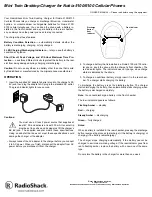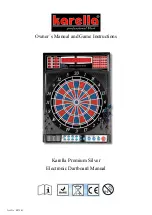
17
PART III : ALIGNMENT
Advantage: For visual observing, the mount does not need to be polar-aligned accurately.
Preconditions: Small cone error in the telescope-mount setup.
Rules for choosing alignment stars:
• The deviation in R.A. of the two alignment stars should not be too small or too close
to 12 hours; the recommended deviation is between 3 hours and 9 hours.
• If there is cone error in the telescope-mount setup or if users are not sure about it,
it is recommended to choose two alignment stars that are on the same side of the
meridian. The absolute values of the two alignment stars’ declination should better
deviate between 10 to 30 degrees.
Note:
If the polar alignment of the mount is good, it is not necessary to choose “
2-Star
alignment
” to align the mount, use the “
1-star alignment
” instead.
Advantages:
• Good pointing accuracy; even the telescope-mount system has cone error.
• For visual observing, the mount does not need to be accurately polar-aligned.
Preconditions: The skies of both sides of the meridian are clear of obstructions.
Rules for choosing alignment stars:
• The 3 alignment stars should be spread out on both sides of the meridian.
• For the two alignment star on the same side of the meridian, the deviation in their
R.A. should be greater than 3 hours, and the absolute value of the difference of the
two alignment stars’ declination should be between 10 to 30 degrees.
( 10° < |Dec1 – Dec2| < 30°)
• If there is cone error in the telescope-mount setup or users are not sure about it,
avoid the situation that all 3 alignment stars have small declination (close to the ce-
lestial equator).
Note:
If users are sure that there is no (or very small) cone error in the telescope-mount
system, then it is not necessary to choose the “
3-star alignment
” to align the mount. Use
“
1-star alignment
” or “
2-star alignment
” instead.
The “
Brightest Star Alignment
” tends to design for entry level users who cannot identify
stars in the night sky, and the “
2-Star alignment
” is for users who know the names of the
stars in the night sky. Both alignment methods provide the same level of precision.
Rules for choosing alignment stars:
• It is recommended that the altitude of the two alignment stars are between 15 and 60
degrees and the deviation of altitude is between 10 and 30 degrees.
• The azimuth deviation of the two alignment stars can be between 45 and 135 de-
grees, it is best to be close to 90 degrees.
2.
Equatorial Mount with 2-Star Alignment:
3.
Equatorial Mount with 3-Star Alignment:
4.
Alt-azimuth Mount:
















































